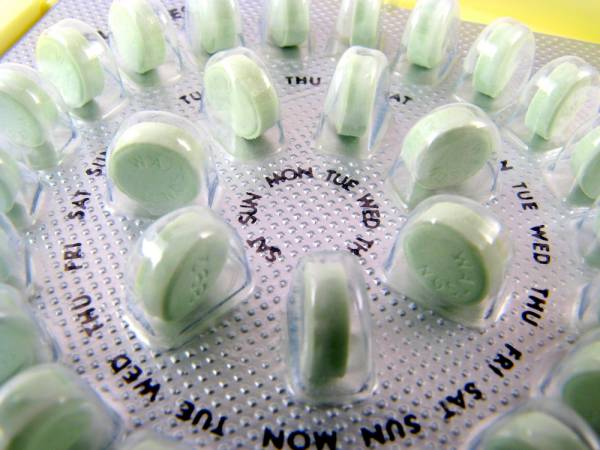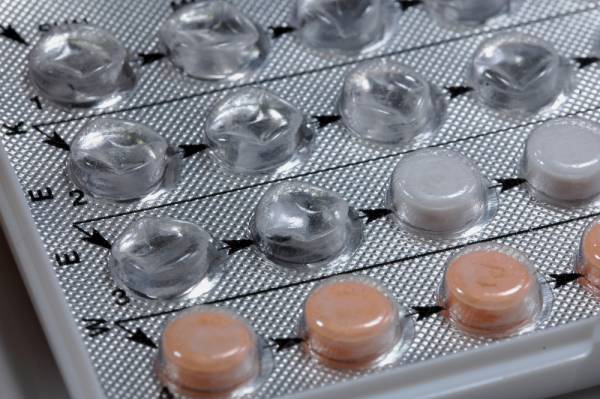Did you ever wonder if perhaps the reason you haven’t been able to reach your deadlift goal or see your abs might be related to that little pill you take every morning to keep you from having a kiddo? It’s not something that’s discussed very frequently in the fitness world, which is surprising to me.
Most of us are well aware of the effects that synthetic, anabolic steroids have on the body in relation to fitness. Yet, most of us know very little about what the synthetic estrogens and progestins have on our bodies other than keeping us from having a little one. I think it’s time we shed a little light on this topic. Shall we?
The Menstrual Cycle and Associated Hormone Levels
First, let’s review the menstrual cycle briefly. The menstrual cycle begins on the first day of menses (the period) and continues for about 28 days on average. During that time a series of events happens within the body to prepare the uterus for conception. Ovulation, when a female’s ovaries release an egg to possibly be fertilized, occurs typically around day 14 of the cycle. At this time the sex hormones estradiol and testosterone peak. Testosterone causes sex drive, energy levels, mental sharpness, and mood to all increase. To put it simply, it makes us ladies much more likely to want to get jiggy with it and makes us more attractive to our partners. The increase in estradiol causes the endometrial lining (the inside of the uterus) to grow thick in case egg and sperm happen to meet so that the uterus is primed with a nice fluffy, nourishing lining for the embryo. After ovulation occurs, progesterone, another sex hormone, rises. If conception occurs, progesterone stays high. If not, progesterone abruptly falls, causing the lining of the uterus to shed and menses to start.
That sounds all fine and good. But, some of us aren’t ready to have kiddos just yet. So we go to our doctors, get a script for birth control and continue on right? It sounds simple but this everyday medication does some pretty profound things once ingested. Let us review. Birth control pills are generally made up of a synthetic estrogen and progestin that are taken for 2.5-3 weeks followed by 4-7 days during which a placebo pill is taken and a “period” occurs. There is no real “period.” This bleeding only occurs as a result of going off the synthetic hormones. These combination pills work by preventing the body from ovulating and thickening the cervical mucus, thus blocking the sperm from reaching the egg.
The Other Effects of the Birth Control Pill
So, cool right? If a woman doesn’t want to get pregnant she just takes these handy dandy pills that suppress ovulation and put up sperm road blocks until she’s ready to get pregnant. But wait a second. Remember that whole bit about ovulation and testosterone? If we’re suppressing ovulation guess what doesn’t happen? The body doesn’t get that bump in testosterone. Ruh-roh. For those of us with athletic and body composition concerns, this presents a problem.
 Without testosterone, or without adequate amounts, it’s hard to build strength, muscle mass, and very hard to maintain a favorable body composition. Not impossible; just much harder. Also, when you don’t get that testosterone boost, your mood and libido is negatively affected. So, I guess you could say that birth control also helps to prevent pregnancy by making the patient totally uninterested in having sex. Taking birth control pills also has the side effect of causing something called sex hormone binding globulin (SHBG) to increase. The liver produces this in response to the ingestion of oral estrogen and has a high binding affinity for testosterone. So, not only are the ovaries not making as much testosterone because of the suppression of ovulation, but what little is circulating is likely to be bound up by SHBG that has gone wild because of the ingestion of the birth control pill. Oh, boy. But wait, we’re not done.
Without testosterone, or without adequate amounts, it’s hard to build strength, muscle mass, and very hard to maintain a favorable body composition. Not impossible; just much harder. Also, when you don’t get that testosterone boost, your mood and libido is negatively affected. So, I guess you could say that birth control also helps to prevent pregnancy by making the patient totally uninterested in having sex. Taking birth control pills also has the side effect of causing something called sex hormone binding globulin (SHBG) to increase. The liver produces this in response to the ingestion of oral estrogen and has a high binding affinity for testosterone. So, not only are the ovaries not making as much testosterone because of the suppression of ovulation, but what little is circulating is likely to be bound up by SHBG that has gone wild because of the ingestion of the birth control pill. Oh, boy. But wait, we’re not done.
Remember that I said birth control pills contain synthetic estrogen and progestin. The word synthetic should raise a red flag right off the bat. Most of us are really trying to limit the amount of synthetic junk we take in so why would be willingly ingest fake hormones?
Let’s review what science and studies have shown us, so we’re clear on why the synthetic hormones are no bueno. Combination birth control pills significantly increase the risk of venous thrombosis according to multiple research studies. This has a lot to do with the how the liver processes these synthetic hormones and the subsequent increased clotting factors and increased platelet aggregation. So, if you take combination birth control pills you should be aware that you are at a greater risk for blood clots. No one wants a blood clot to the lung, right? That could really screw with your conditioning workouts.
Birth control has also been linked to an increased risk of myocardial infarction (the old heart attack). Heart attacks are detrimental to your workout, FYI. Oh and a few more things: Long term use of combination pills has also been shown to increase the risk of breast cancer. Yes, breast cancer. Studies indicate the younger one begins taking the pill and the longer one is on the pill the greater the risk of developing breast cancer. This is believed to be caused by stimulation of the breast cells by the synthetic hormones and possible damage to growing cells in those women taking the pill at young ages while their breast tissue is still developing. Stimulation of breast tissue may sound like fun and games, but once a woman has gone through puberty you really do not want anything growing in the breast region besides your pecs.
 People, I can hear you hurling insults at the computer right now. Trust me on this one. Oh, and remember the study a few years back called the Women’s Health Initiative (WHI) that studied hormone replacement therapy for menopausal women? You may not, but I do. The study revealed that the traditional estrogens and progesterones, also synthetics, given to women to treat menopausal symptoms were linked to increased risk of heart disease, breast cancer, and stroke, among other problems. Doctors everywhere had their patients stop taking these drugs immediately because of the study’s findings. Did you also know that the amount of synthetic estrogen and progesterone in birth control pills is higher than that given to those menopausal women? Yet, doctors are not having women stop using oral birth control pills. Hmm. I bet your physician did not go over all this with you when she gave you your prescription, did she?
People, I can hear you hurling insults at the computer right now. Trust me on this one. Oh, and remember the study a few years back called the Women’s Health Initiative (WHI) that studied hormone replacement therapy for menopausal women? You may not, but I do. The study revealed that the traditional estrogens and progesterones, also synthetics, given to women to treat menopausal symptoms were linked to increased risk of heart disease, breast cancer, and stroke, among other problems. Doctors everywhere had their patients stop taking these drugs immediately because of the study’s findings. Did you also know that the amount of synthetic estrogen and progesterone in birth control pills is higher than that given to those menopausal women? Yet, doctors are not having women stop using oral birth control pills. Hmm. I bet your physician did not go over all this with you when she gave you your prescription, did she?
Make Conscious Choices
Is this making you think twice about your current method of birth control? I hope so. Why would we willingly take something that is most likely hindering our ability to gain muscle, get stronger, and maintain a lower body fat percentage not to mention put as risk for potentially lethal side effects? I know many of you are thinking, “Because I don’t want a mini-me yet!” Some of you may also be taking birth control to “fix” other problems, like heavy or irregular cycles. So what’s a girl to do? I’ll tell you. Next week I’ll outline alternatives to traditional birth control so you can reach your athletic goals and delay baby-making until you’re ready.
References:
1. Coenen C, Thomas C, Borm G, Hollanders J, and Rolland R, “Changes in androgens during treatment with four low-dose contraceptives.”, Contraception 53(1996):171-6.
2. Kemmeren, Jeanet, Algra, Ale, and Grobbee, Diederick, “Third generation oral contraceptives and risk of venous thrombosis: meta-analysis.” British Medical Journal 323 (2001): 131.
3. Makhzancy, M., Wynn, V., and Lawrence, D., “Sex hormone binding globulin capacity as an index of oestrogenicity or androgenicity in women on oral contraceptive steroids.”, Clinical Endocrinology 10 (1979): 39-45.
4. Panzer C, Wise S, Fantini G, Kang D, Munarriz R, Guay A, and Goldstein I, “Impact of oral contraceptives on sex hormone-binding globulin and androgen levels: a retrospective study in women with sexual dysfunction.”, The Journal of Sexual Medicine 3(2001):104-13.
5. Poller, L., “Relation between oral contraceptive hormones and blood clotting.”, Journal of Clinical Pathology 3 (1969): 67-64.
6. Tanis M.D., Bea, Maurice M.D., A.A.J., den Bosch M.D., Van, Kemmeren Ph.D., Jeanet M., Cats M.D., Volkert Manger, Helmerhorst M.D., Frans. M., Algra M.D., Ale, van der Graaf M.D., Yolanda, and Rosendaal M.D., and Frits R., “Oral contraceptives and the risk of myocardial infarction.”, New England Journal of Medicine 345 (2001): 1787-1793.
7. White, E., Malone, K., Weiss, N., and Daling, J., “Breast cancer among young U.S. women in relation to oral contraceptive use.”, Journal of National Cancer Institute 86 (1994): 505-14.
8. Zhu, J., Lei, X., Wang, Y., “Oral contraceptive use and risk of breast cancer: a meta-analysis of prospective cohort studies.”, European Journal of Contraceptive and Reproductive Health Care 17 (2012): 402-14.
Photos courtesy of Shutterstock.






